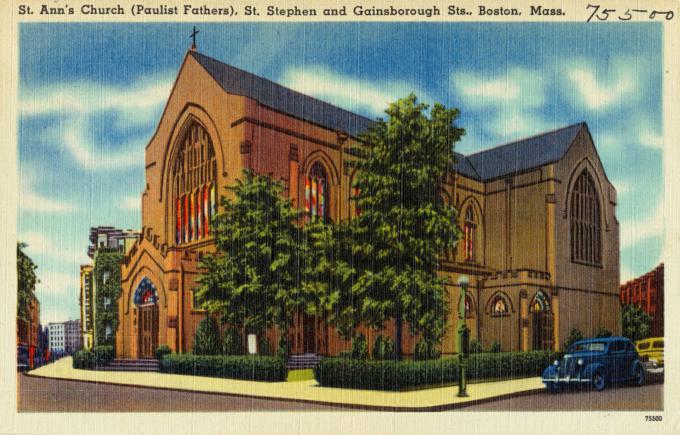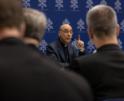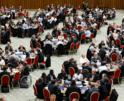
Culture
Very quickly, St. Ann became known as Boston's "University Parish," a church that ministered not only to the faithful within its boundaries, but also to students across the city.
At the corner of St. Stephen and Gainsborough Streets in Boston's Fenway neighborhood stands a tan brick building with an ornamental red door. Now a performing arts center, the building was once known as Boston's "University Parish," a hub for Catholic students attending the city's colleges and universities.
The church building at 77 St. Stephen Street was built in 1892 as a Protestant church, the Episcopal Church of the Messiah. In 1928, Cardinal William O'Connell purchased the property to serve as a mission church of St. Cecilia in Back Bay, which had experienced a surge in its membership since its dedication in 1894. The cardinal dedicated the church to St. Ann on the feast of Christ the King. "This is now a sanctuary of God," he proclaimed at the church's dedication Mass, "Where the sacrifice of Mass will be offered daily and weekly for the glory of God and the welfare of souls."
For nearly two decades, St. Ann remained a mission church staffed by the priests of St. Cecilia. It did not become its own parish until 1945, when Cardinal Richard Cushing entrusted it to the care of the Missionary Society of St. Paul, also known as the Paulist Fathers. Cardinal Cushing had invited the Paulists to Boston earlier that year to establish a Catholic Information Center overlooking Boston Common. Recognizing that the fathers would need a home, he designated St. Ann a geographical parish under their care. To accommodate their numbers, the archdiocese purchased three parcels of land at 68, 70, and 72 St. Stephen Street for a rectory and church hall. The first Paulists arrived at St. Stephen Street in April 1945; among them was Father Henry P. Fisher, who became the first pastor of St. Ann.
Although St. Ann was designated as a traditional geographical parish, from the outset the Paulist Fathers envisioned a broader mission. Situated as the church was -- adjacent to Northeastern University and a stone's throw from Wentworth University of Technology, Massachusetts College of Art and Design, and Simmons College -- the Paulists naturally turned their attention to the needs of students at local non-Catholic Colleges. Very quickly, St. Ann became known as Boston's "University Parish," a church that ministered not only to the faithful within its boundaries, but also to students across the city.
The Paulist Fathers were well-suited for the kind of ministry they took up at St. Ann. Their society had helped to pioneer the "Newman Movement" or "Newman Apostolate" in North America. Inspired by the ministry and writings of St. John Henry Newman (1801-1890), an English cardinal, this movement sought to introduce Catholic student organizations ("Newman Clubs") and Catholic campus ministries ("Newman Centers") on the campuses of public universities and colleges. The Paulists' first Newman Center in the United States opened at the University of California at Berkeley in 1907.
At St. Ann, the fathers became steadfast advocates for Catholic students seeking to establish Newman Centers on their campuses. In February 1947, for example, Father Fisher wrote to the chancellor, "The Catholic students of Mt. Ida Junior College, Newton Center, numbering about 60, wish to form a Newman Club... would it be possible to appoint a chaplain for them?" Later that year, the Paulists came to the aid of students fighting the administration of Suffolk University, which was reluctant to allow a Newman Center on campus for fear of "stirring up religious controversies." They urged Auxiliary Bishop John Wright to write a letter in support of the students, and the bishop obliged. "Normally I would not wish to embarrass you in any way by intervening in a matter of this kind," he wrote to Suffolk's dean in 1947, "But I am impressed by the persistence of your undergraduates and a few alumni in attempting to secure action on their wish for a Newman Club."
The Paulist Fathers were more than mere advocates for Newman Centers, however; they were active and visible presences on college campuses across the city. They offered on-campus masses on Holy Days of Obligation at such secular institutions as Massachusetts Institute of Technology and Simmons College. In the 1970s, they established RCIA (Rite of Christian Initiation of Adults) programs for students seeking to become Catholic or to complete their sacraments. Their immediate success is evident from numerous letters to the Chancellor's Office throughout the 1940s and 1950s, each seeking to add more Mass times to alleviate crowded conditions in the church. Indeed, by 1948, the Paulists at St. Ann offered seven Masses on Sundays and eight on Holy Days -- and these were so well attended, with chairs up the aisles and some parishioners even standing outside, that they had to add additional Masses in the church basement.
The Paulists withdrew from St. Ann in 1979, citing several factors including personnel shortages and a declining residential population in the area around the church. Yet, perhaps the most significant factor in their decision to depart was the success of the Newman programs they established throughout the city -- programs that ultimately made their ministry redundant.
St. Ann returned to archdiocesan control and remained a geographical parish until its closure in 2004.
VIOLET HURST IS AN ARCHIVIST FOR THE ARCHDIOCESE OF BOSTON.
Recent articles in the Culture & Events section
-
'Dignitas' and the mediaRussell Shaw
-
Scripture Reflection for April 14, 2024, Third Sunday of EasterDeacon Greg Kandra
-
St. Helena's House is established in the South EndThomas Lester
-
Is this synodality?Russell Shaw
-
Poking the hornet's nest of IVFFather Tadeusz Pacholczyk


















